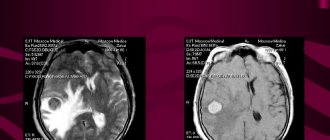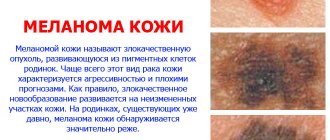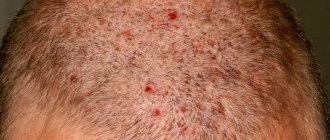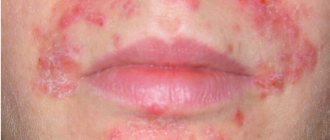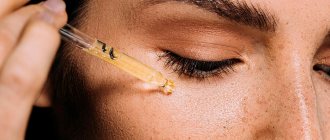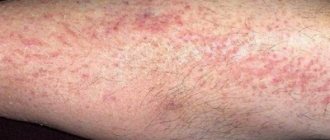What melanoma is and what methods of treatment exist, the oncologist explains to the patient at the first appointment. Immunotherapy for melanoma is one of the effective methods of stopping the pathological process, in which the defense of the immune system is activated by special medications. As a result, cancer cells die. Immunotherapy can be either an independent treatment method or a complex one. It is used to suppress the activity of primary and secondary malignant tumors.
How is chemotherapy different from immunotherapy?
Chemotherapy (CT) and immunotherapy (IT) kill tumor cells, only antitumor cytostatics interfere in various ways with the life cycle of a melanoma cell, forcing it to apoptosis - programmed death. As practice shows, tumor cells actively resist the intervention of a chemotherapy drug, developing resistance to drugs.
Immuno-oncological drugs also lead the malignant cell to death, activating the natural immune defense in different ways. Without the participation of drugs, it is reckless to hope for the protection of natural immunity - it “sleeps”, deliberately not reacting to the body’s cells, and cancer cells are also a “native” part of the body. Additionally, the tumor produces special proteins that dampen any attempts at an immune response. Immunotherapy allows immune defenders to see the cancer and take action to destroy it.
How is it carried out?
Immunotherapy for melanoma begins to be used no earlier than the 2nd stage of the disease, usually after surgery, when the immune system begins to need support.
Treatment with immunomodulatory drugs is carried out only in a hospital setting:
- The active method is used at the initial stage of the disease to strengthen the body; the result is achieved gradually by strengthening the work of the protective cells of the immune system.
- Passive involves the administration of drugs with antibodies that spread throughout the body and destroy cancer cells.
There is no specific immunotherapy regimen for melanoma. For each patient, the oncologist develops an individual treatment plan. Immunomodulatory drugs are administered intravenously over several weeks at intervals of several days. In the final stages of melanoma development, which cannot be treated surgically, the dose of medication is significantly increased. This achieves the maximum effect of immunotherapy and increases the patient’s life expectancy.
How do immune drugs work for melanoma?
Immuno-oncological drugs are monoclonal antibodies (MAbs), that is, protein bodies synthesized by the body in response to the presence of an enemy agent, usually bacteria and viruses. Antitumor mAbs - pembrolizumab (Keytruda) and nivolumab (Opdivo) on the surface of melanoma cells block the synthesis of certain proteins that allow the immune system not to notice melanoma.
The monoclonal antibody ipilimumab (Ervoy) alters the sensitivity of the immune system's main defender, the T-lymphocyte, to make it more active in attacking cancer cells.
In the treatment of melanoma, a natural protein product is used - alpha interferon (α-IFN), synthesized by the body's cells in response to the invasion of viruses, only in much higher concentrations - hundreds and thousands of times higher than the entire body is capable of reproducing. The mechanism of the antitumor effect of interferon alpha is not entirely clear, but numerous clinical studies have shown positive results from its use to prevent relapse.
Types of cancer immunotherapy
Treatment of cutaneous melanoblastoma (outdated name) is carried out by several types of immunotherapy:
- Active - the patient is prescribed medications that activate or tune the body's natural forces against a specific type of cell.
- Passive - involves the introduction of ready-made antibodies into the sick body. They are a synthetic analogue of immune products that are produced to suppress cancer.
Active immunotherapy for melanoma involves cytotoxic T cells. They destroy foreign cells by contact with them. The passive method of immunotherapy involves:
- monoclonal antibodies - capable of suppressing any potentially dangerous substance (antigen);
- cytokines - control the development of immunity and contribute to its self-regulation;
- lymphocytes - influence the antigen in the extracellular space.
Targeted drugs for melanoma
The third group of antitumor drugs, targeted drugs, are also aimed at killing malignant cells, but through interference with the intracellular biochemical reaction. A failure in one biochemical link leads to disruption of the entire life process and death of the cell.
Predictors of the effectiveness of targeted drugs are certain gene mutations in the DNA of a cancer cell. Melanoma with a mutation in the CKIT gene will benefit from targeted imatinib. If BRAF mutations are present in malignant melanoma, a positive outcome is expected from the use of cobimetinib or trametinib together with vemurafenib or dabrafenib.
Targeted drugs are used only if there are markers in the cell - mutations; if within a month after the operation it is not possible to determine the genetic status, then it is considered that the mutation is absent.
Advantages and disadvantages of immunotherapy
The advantage of this type of treatment is that it acts in a generalized manner . Immune cells penetrate almost all affected tissues and organs, and do not affect those that are not affected by melanoma.
Thus, all tumor cells are exposed to the drugs, regardless of their location.
Interferon and its analogues are capable of slowing tumor cell growth and subsequently destroying them through the T-cell component of immunity in all metastatic foci. This gives hope for a complete cure or an increase in the duration of the disease-free period.
However, this method also has its drawbacks. Immunotherapy is toxic to the body; many patients have to reduce the dose of the administered substance, which casts doubt on the therapeutic effect.
Immunotherapy negatively affects the tissues of the liver, kidneys, brain, skeletal muscles and heart muscle. Side effects when using this type of therapy are very common .
Photo 2. Skin rashes are one of the common side effects of interferon. Source: Flickr (micayylarr)
It is important! If any side effect occurs, it is necessary to reduce the dose of the drug or switch to its analogue. It has been proven that deviations from the standard course of treatment reduce the effectiveness of immunotherapy. In some cases, it is necessary to raise the question of abandoning this method of treatment.
When is immune therapy indicated?
After surgery, preventive drug treatment is not carried out only in cases of favorable melanoma in the initial stages - I-II; in all other situations, preventive treatment is necessary, and it must be started no later than 9 weeks after the operation. The duration of therapy is 1 year, if the patient is able to tolerate it.
Prophylaxis or adjuvant therapy can be carried out with interferon alpha or ipilimumab (Yervoy), which in clinical studies has shown a clear advantage in overall and disease-free survival and in reducing the likelihood of death from melanoma.
Contraindications for immunotherapy: severe chronic diseases of the heart, kidneys or liver, autoimmune processes and psoriasis, mental illness and pregnancy.
The treatment cannot be called easy, but over time, the tolerance of alpha-interferon improves for the majority - the temperature normalizes, aches in the muscles and joints go away, but the biochemical composition of the blood may worsen and weakness remains.
Efficacy and side effects of therapy
Benefits of immunotherapy:
- Application at almost all stages of cancer;
- Ease of use;
- A small list of contraindications;
- Increased life span;
- Duration of remission time;
- Reducing the number of relapses;
- The effectiveness is more noticeable compared to chemotherapy.
Among the disadvantages are the high cost of immunostimulating drugs, the high possibility of autoimmune diseases and strong pressure on the immune system.
Side effects have been identified for all drugs used in the treatment of malignant tumors. Drug immunotherapy for melanoma is no exception. Therapy aimed at maintaining immunity can backfire and begin to attack healthy cells. Consequences can occur initially and over a long period of time.
In case of complications, the medicine is discontinued and hormonal therapy is started to restore the damaged cells of the body to their original state.
Side effects:
- Allergy. It usually appears as slight redness with a feeling of itching. Possible anaphylactic shock.
- Blood pressure may drop to the lower limits.
- Drug fever. Difficult to control high body temperature.
- May stimulate the digestive system and cause nausea, dry mouth, and vomiting.
- In rare cases, disturbances in the functioning of certain organs are noted.
Treatment of advanced melanoma
For inoperable or metastatic melanoma without a gene mutation or with unknown genetics, treatment begins with the immuno-oncology nivolumab (Opdivo) or pembrolizumab (Keytruda). ipilimumab (Ervoy) shows good results
For BRAF mutations, targeted therapy with a two-inhibitor regimen is offered in the first line: cobimetinib with vemurafenib or trametinib with dabrafenib. When their effectiveness is exhausted or they are insensitive, mAbs are used: either nivolumab (Opdivo) every two weeks or pembrolizumab (Keytruda) every three weeks. And only in the third line of melanoma progression do they resort to chemotherapy .
CKIT gene mutation nivolumab (Opdivo) or pembrolizumab as the first agent . If the patient prefers tablet forms, you can start with daily imatinib . In case of progression of the metastatic process, they switch to what was not used in the first line - immuno-oncological drugs are replaced with imatinib, imatinib - with immuno-oncological drugs. In the third line comes chemotherapy .
Immune checkpoint inhibitors (ICIs)
This is a relatively new group of promising drugs for the treatment of metastatic melanoma. An important property of the immune system is its ability to restrain its activity against healthy cells of the body. This uses “checkpoints,” which are proteins on the membranes of immune cells that must be “turned on” (or “off”) for an immune response to begin. Melanoma cells sometimes act on checkpoints to prevent immune system aggression. IICT drugs, interacting with checkpoint proteins, help restore the immune response and aggression towards melanoma cells.
In accordance with the updated recommendations of the US National Comprehensive Cancer Network (NCCN) for the treatment of melanoma (2016), as the first line of treatment for unresectable or advanced melanoma, experts recommend the use of checkpoint inhibitors (checkpoint immunotherapy) and BRAF-targeted therapy for patients with mutation in the BRAF gene.
PD-1 inhibitors
Pembrolizumab (Keytruda) and Nivolumab (Opdivo) are drugs that target the cell membrane protein PD-1 (programmed cell death 1) of the immune system's T cells, which normally help immune cells avoid attacking other cells in the body. By blocking PD-1, these drugs enhance the immune response against melanoma cells. The use of these drugs reduces tumor size and increases life expectancy (although it has not yet been reliably established whether these drugs can cure melanoma). These drugs are intended for intravenous use. Traditional adverse reactions may include weakness, cough, nausea, itching, loss of appetite, constipation, joint pain, and diarrhea. More serious complications are observed less frequently. The main effect of the drugs is to reduce inhibition of the immune system. In this regard, side effects can occur when the immune system begins to attack other organs: lungs, intestines, liver, endocrine organs, kidneys - then life-threatening complications develop, which may require discontinuation of medications. Immunotherapy with PD-1 inhibitors for melanoma, according to experts, has good prospects and requires additional large-scale study.
CTLA-4 inhibitor
Yervoy (ipilimumab) also activates the immune response, but has a different target, the CTLA-4 protein. By blocking its activity, the drug counteracts the growth of cancer cells.
Intended for intravenous use once every three weeks. In patients with melanoma that cannot be removed by surgery or has spread to other parts of the body, the drug increases life expectancy, although it is still not clear whether it can cure melanoma. In addition to common adverse reactions, this drug is much more likely than PD-1 inhibitors to cause serious side effects, provoking an attack by the immune system of the intestines, central nervous system, liver, skin, eyes, endocrine organs, which can be associated with life-threatening complications.
Surgical intervention
Surgery is the standard treatment for melanoma in the early stages, while the tumor is localized and has not formed distant metastases. If, upon examination with a dermatoscope, the doctor suspects the malignant nature of the neoplasm, the tumor is excised to the full depth of the skin and sent for a biopsy. If microscopic examination confirms melanocarcinoma, the scar is resected, the area of tissue removed will depend on the detected thickness of the tumor.
If the thickness of the tumor exceeds 0.75 mm, a biopsy of the so-called sentinel lymph node is performed - one of the group of regional lymph nodes that receive lymph flow from the affected area of the body. If malignant cells are found in the biopsy, the entire lymph collector is removed. The patient is recommended for in-depth examination to search for distant metastases, and surgical treatment is supplemented with medication.
Since excision of melanoblastoma for biopsy does not require general anesthesia, it has virtually no contraindications. If the process affects the lymph nodes and requires their removal, the operation may be contraindicated if the patient’s physical condition does not allow general anesthesia.
Surgical treatment is not indicated in a situation where immediate removal of the tumor is impossible: the affected lymph nodes are a conglomerate fused to the surrounding tissues that cannot be separated. Most often, surgery is not indicated when there are distant metastases in the bones, brain, or liver. It is extremely rare that such a lesion is a single formation. Usually in these cases drug therapy is prescribed.
It is strictly forbidden to remove formations suspicious for melanoma with a laser, using electrocoagulation or other methods that do not leave material for histological examination.
Chemotherapy
Melanoma is extremely difficult to respond to chemotherapy, so chemotherapy is rarely used for melanoma. Typically, the indication for such treatment is the inability to treat with other methods in unresectable (unremovable) or metastatic form. Or chemotherapy is prescribed as a second line, when it becomes clear that it is not possible to effectively treat the tumor with immunotherapy.
Drugs used:
- Dacarbazine;
- Temozolomide (Temodal, Temamid, Temcital, Tezolom, Astroglyph);
- Arabinopyranosyl methyl nitrosourea (Aranose);
- Cisplatin (Kemoplat, Platinol, Platidian, Oncoplatin, Blastolem);
- Vinblastine (Velbe);
- Paclitaxel (Taxol, Taxacad, Abitaxel, Intaxel);
- Carboplatin (Parakt, Kemocarb, Carbotera).
The drugs are administered intravenously, the duration of use is 1 - 5 days, the duration of 1 course of chemotherapy is from 21 to 35 days, depending on the specific drug (or combination thereof) and the patient’s condition.
Causes
Stage 2 melanoma is diagnosed when the tumor reaches no more than 2 mm in size and grows to a depth of 4 mm. The surface of the lesion may become covered with ulcers, and tissues in the form of pointed rays may grow from the tumor site in different directions.
It is impossible to say for sure why skin melanoma develops at stage 2. Doctors have identified risk factors - events or phenomena that increase the likelihood of disease:
- genetic predisposition - the presence of malignant tumors in close relatives, especially skin tumors;
- excessively long exposure to the sun - passion for sunbathing, solariums;
- very fair, white skin, red hair;
- the presence of many pigment spots;
- history of sunburn;
- inflammatory skin diseases in medical history.
Often, pathology develops even without heredity, if the genes responsible for the division of skin cells are transmitted with “errors”.
Prognosis and life expectancy
With stage 2 melanoma, life expectancy depends on how early the diagnosis was made and the tumor was detected. At the second stage, the survival rate is 47% if the depth of tumor germination is less than 4 mm. It is important to remember that this is a general assessment. It also depends on the characteristics of the course of the disease, associated factors and diseases.
Statistics may also not take into account recent developments and new drugs used in therapy. The earlier the tumor is detected, the greater the likelihood of going into stable remission or complete recovery, and the better the prognosis for stage 2 melanoma.
Prevention
The main method of prevention is to avoid excessive sun exposure. You should use sunscreens with a high protection index, wear glasses, hats, and clothes made from natural fabrics that will cover your skin as much as possible in the summer.
If you have a hereditary predisposition, you should regularly visit a dermatologist for preventive purposes. You will also need to consult a doctor if there is a change in pigmentation on the skin. Do not tear or otherwise damage existing moles or try to remove them yourself.
Melanoma in the second stage is treatable. If you consult a doctor in a timely manner, you can not only go into stable remission, but also completely recover from cancer. In the future, regular examination and diagnostics will be required, first once every 3 months, then once every 6 months.
Author: Vladislava Matveeva, doctor, especially for Dermatologiya.pro
Interferon-alpha as adjuvant therapy
Often the greater thickness of melanoma is accompanied by the spread of tumor cells to distant organs. Even after surgical removal of all visible melanoma, some tumor cells remain in the body. In such cases, after surgery, interferon-alpha may be used as an additional therapy. This helps prevent melanoma from further growing and spreading. This treatment helps delay tumor recurrence.
It is necessary to administer the drug in large doses for interferon to be effective. However, not all patients are able to tolerate the side effects. Therefore, treatment with interferon should be carried out under close medical supervision.
Use of cytokines
Protein compounds called cytokines activate the immune system. In the treatment of melanoma, synthetic analogues of natural cytokines are used: interleukin-2 and interferon-alpha. These drugs are given intravenously at the beginning of tarvia, and subsequently the drugs can be administered subcutaneously by the patient or caregivers at home. These drugs help reduce the size of advanced melanoma in 10-20% of patients. For stage IV tumors, cytokines can be administered simultaneously with chemotherapy.
Side effects of cytokines include flu-like symptoms and a drop in white blood cell counts. Interleukin-2 can cause fluid retention in the body. This can lead to swelling. IL-2 treatment is carried out only in specialized centers due to the risk of serious side effects.
Diagnostics
Early diagnosis begins in the dermatologist's office. The doctor identifies 6 main signs of degeneration:
- asymmetry of the edges - a conditional axis in the center of the mole divides it into two uneven halves;
- edges – the appearance of uneven edges;
- bleeding - discharge of ichor or blood from the lesion;
- dynamics - the appearance of crusts, erosions, loss of skin pattern;
- color – changes and unevenness of color;
- Dimensions – increase in height, width.
A preliminary diagnosis is made even without additional procedures, and is clarified using instrumental and laboratory techniques:
- Dermatoscopy is a diagnostic technique that does not injure the neoplasm, but allows you to determine its boundaries, pigmentation density, and record the parameters of the neoplasm. This allows you to track dynamics.
- Computer diagnostics – the use of a videodermoscopic system or epiluminescent dermatoscopy. A small camera approaches the lesion and scans it, sending a detailed image to the PC screen. Here the doctor can examine the lesion in three-dimensional mode.
The most accurate diagnosis is histological. During a biopsy, a small amount of tissue is removed and its cells are examined. The technique allows you to clarify the diagnosis, establish the course of melanoma, its stage. Rate:
- melanoma cell type;
- degree of maturity;
- level of tumor aggressiveness;
- depth.
Histology also determines whether the tumor is completely removed after excision of melanoma. Additionally, a biochemical blood test is prescribed to determine tumor markers and foci of inflammation.
Useful video about melanoma
List of sources:
- Demidov L.V., Sokolov D.V., Bulycheva I.V. Improving methods for diagnosing skin melanoma / Bulletin of the Russian Cancer Research Center named after. N. N. Blokhin RAMS. – t.18. - No. 1. – 2007.
- Demidov L. V., Orlova K. V. Individualization of drug treatment for skin melanoma / Russian Cancer Research Center named after. N. N. Blokhin RAMS. – v.14. - No. 4. – 2013.
- Sokolov D.V. Dermatoscopy in early diagnosis and screening of skin melanoma / Abstract of the dissertation. - Moscow. – 2009.
- Demidov L.V., Utyashev I.A. Surgical treatment of skin melanoma / Russian Cancer Research Center named after. N. N. Blokhin RAMS. – v.13. — No. 2. – 2012.
There are no similar articles.
Symptoms
Melanoma at stage 2A does not always immediately give a clear clinical picture. The focus of the disease is characterized by:
- growth of the spot and its hardening;
- increased pigmentation;
- redness around the spot;
- swelling around the mole;
- pigmented radiant growths from the focus.
Sometimes at this stage, melanoma manifests itself only by enlargement of nearby lymph nodes, since they are the first obstacle to the outflow of lymph. Pigmented or colorless nodules appear near the lesion.
Another initial sign in this stage is an increase or decrease in skin pigmentation. Particular attention is paid to pigmented or non-pigmented growths from the primary focus, which spread the process into normal tissues.
